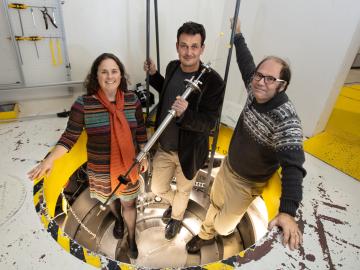
Filter News
Area of Research
- (-) Energy Science (45)
- (-) Neutron Science (15)
- (-) Nuclear Science and Technology (4)
- Advanced Manufacturing (4)
- Biological Systems (1)
- Biology and Environment (6)
- Computer Science (3)
- Fusion Energy (2)
- Materials (61)
- Materials for Computing (3)
- National Security (8)
- Quantum information Science (3)
- Supercomputing (18)
- Transportation Systems (1)
News Topics
- (-) Bioenergy (21)
- (-) Chemical Sciences (2)
- (-) Cybersecurity (4)
- (-) Grid (11)
- (-) High-Performance Computing (1)
- (-) Materials Science (25)
- 3-D Printing/Advanced Manufacturing (36)
- Advanced Reactors (12)
- Artificial Intelligence (6)
- Big Data (3)
- Biology (2)
- Biomedical (16)
- Biotechnology (2)
- Clean Water (6)
- Composites (4)
- Computer Science (24)
- Coronavirus (15)
- Energy Storage (23)
- Environment (34)
- Exascale Computing (1)
- Fusion (7)
- Isotopes (6)
- Machine Learning (7)
- Materials (2)
- Mathematics (2)
- Mercury (2)
- Microscopy (5)
- Molten Salt (5)
- Nanotechnology (11)
- National Security (1)
- Neutron Science (58)
- Nuclear Energy (33)
- Physics (7)
- Polymers (6)
- Quantum Science (5)
- Security (4)
- Space Exploration (5)
- Summit (7)
- Transportation (27)
Media Contacts

Scientists at the Department of Energy’s Oak Ridge National Laboratory have developed a new method to peer deep into the nanostructure of biomaterials without damaging the sample. This novel technique can confirm structural features in starch, a carbohydrate important in biofuel production.

Researchers at ORNL demonstrated that sodium-ion batteries can serve as a low-cost, high performance substitute for rechargeable lithium-ion batteries commonly used in robotics, power tools, and grid-scale energy storage.

An international team of researchers has discovered the hydrogen atoms in a metal hydride material are much more tightly spaced than had been predicted for decades — a feature that could possibly facilitate superconductivity at or near room temperature and pressure.

The formation of lithium dendrites is still a mystery, but materials engineers study the conditions that enable dendrites and how to stop them.

Researchers have developed a new process that could make it much cheaper to produce biofuels such as ethanol from plant waste and reduce reliance on fossil fuels.

To better determine the potential energy cost savings among connected homes, researchers at Oak Ridge National Laboratory developed a computer simulation to more accurately compare energy use on similar weather days.

Illustration of the optimized zeolite catalyst, or NbAlS-1, which enables a highly efficient chemical reaction to create butene, a renewable source of energy, without expending high amounts of energy for the conversion. Credit: Jill Hemman, Oak Ridge National Laboratory/U.S. Dept. of Energy

A technology developed at the ORNL and scaled up by Vertimass LLC to convert ethanol into fuels suitable for aviation, shipping and other heavy-duty applications can be price-competitive with conventional fuels

Scientists at the U.S. Department of Energy’s Brookhaven National Laboratory have new experimental evidence and a predictive theory that solves a long-standing materials science mystery: why certain crystalline materials shrink when heated.

Researchers at the Department of Energy’s Oak Ridge National Laboratory have received five 2019 R&D 100 Awards, increasing the lab’s total to 221 since the award’s inception in 1963.


